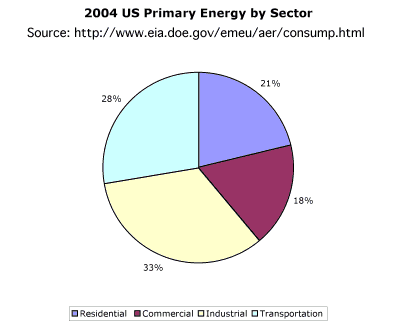Efficiency is doing the same with less energy. For now we will exclude such practical measures as mandating temperatures in public buildings (do DC buildings really need to be so hot in the winter and so cold in the summer?), though estimates below do include driving smaller cars.
World population is increasing by 1.2%/year worldwide, by 0.9% in the United States (the largest greenhouse gas emitter). Per capita consumption is rising in both the developed and developing world, though faster in the latter. How much can we reduce increases in energy by better efficiency policies, and more research?
McKinsey Global Institute addresses this in Productivity of Growing Global Energy Demand. Unless otherwise indicated, all information below comes from their report.
What is current world energy demand?
The largest chunk of world energy consumption is industrial, 31%. Electricity production is second at 22%. Residential energy use (excluding electricity) and transportation (light vehicles and air) are each 19%. Commercial energy use (excluding electricity) is 6%, oil refining is 2%, and agriculture 1%. Obviously these numbers vary regionally – in California, 40% of greenhouse gas emissions comes from transportation.

Source: US Department of Energy. The US devotes a disproportionate amount of energy to transportation.
The richest 1/5 of the world population uses much more than our share of the energy, and emit much more than our share of greenhouse gas emissions.

Source: World Bank
World Population

Source: United Nations Food and Agriculture Organization
If energy productivity rises, energy demand decreases, money is freed up and the economy grows. Improvements can come from smaller appliances and cars, or more efficient ones. From a shift in energy supply, from biomass to electricity, for example. Or with changes in the economy that produce economic growth with less energy consumption, eg, as real wealth shifts from large cars to small computers.
There is significant room for improvement from investments with Internal Rate of Returns greater than 10%. Energy growth could be held below 1% per year – from the expected increase of 2.2%/year between now and 2020 (it would be 3.2%, but baseline scenario includes 1% gain in energy productivity/year).
However, market-distorting subsidies, information gaps, agency issues, and other market inefficiencies all work against energy productivity. Furthermore, the small share of energy costs for most businesses and consumers reduces end-use response to energy-price signals.
So policy changes must include standards, and more and clearer information for the public.
What to do:
• Huge amounts of energy can be saved in residences: better insulation, and higher efficiency bulbs, appliances, and water heating – but these methods have to be used! Only 6% of light bulbs worldwide are compact fluorescents. (See Barriers to Technology Diffusion: The Case of Compact Fluorescent Lamps (pdf). Nine percent of energy, and 8% of GHG, result from worldwide lighting. Compact fluorescent bulbs require 20 – 25% as much energy to produce the same light as an incandescent bulb.) This could produce 16% of possible energy savings between now and 2020.
• More efficient electricity production and transmission. 12% of savings
• Industry can save 40%, particularly in the developing world. Refining and steel manufacture are two big areas.
• China can save 2% itself just by opting for high-efficiency coal plants over the current model, and bringing building shell standards in line with those for similar climates.
Again, standards are important where information is difficult – for individuals, for example. Fuel taxes might be more effective in changing car-buying decisions in the US, with its slow turnover of stock, but China may want to improve its fuel efficiency standards given how many will buy cars soon.
Funding research
McKinsey Global Institute does not address the need for government funded research, but research leads to huge savings. From chapter 3 (pdf) of Federal Energy Research and Development for the Challenges of the 21st Century:
Between 1978 and 1996, the Federal government invested some $8 billion (1997 dollars) in research, development, and deployment of energy efficiency technologies. This work, in conjunction with other policies (such as standards and incentives), private R&D, and the pressure of high energy costs, helped spur a private sector investment achieving the $150 billion in annual savings-a tremendous return on investment. Besides these financial savings, DOE-supported technologies have led to significant improvements in the environment and human health.

Low-e Window
According to Lawrence Berkeley Labs,
Low emissivity windows already installed will save the U.S. $2 billion over their 25-year lifetime.
